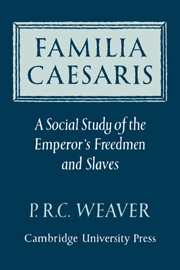Book contents
- Frontmatter
- Contents
- Preface
- Abbreviations
- INTRODUCTION
- PART I NOMENCLATURE AND CHRONOLOGY
- PART II THE FAMILY CIRCLE
- 5 Age at manumission
- 6 Age at marriage
- 7 Status of wives
- 8 Status of children
- 9 The Senatusconsultum Claudianum and the Familia Caesaris
- 10 Women in the Familia Caesaris
- 11 The marriage pattern of slaves and freedmen outside the Familia Caesaris
- PART III THE EMPEROR'S SERVICE
- APPENDIXES
- Bibliography
- Index
5 - Age at manumission
Published online by Cambridge University Press: 07 October 2011
- Frontmatter
- Contents
- Preface
- Abbreviations
- INTRODUCTION
- PART I NOMENCLATURE AND CHRONOLOGY
- PART II THE FAMILY CIRCLE
- 5 Age at manumission
- 6 Age at marriage
- 7 Status of wives
- 8 Status of children
- 9 The Senatusconsultum Claudianum and the Familia Caesaris
- 10 Women in the Familia Caesaris
- 11 The marriage pattern of slaves and freedmen outside the Familia Caesaris
- PART III THE EMPEROR'S SERVICE
- APPENDIXES
- Bibliography
- Index
Summary
It is generally assumed that manumission was not difficult for an intelligent, energetic and thrifty slave in the early Empire. Apart from other evidence, the legislation of Augustus to regulate manumission – the lex Iunia, the lex Fufia Caninia and the lex Aelia Sentia – points to the prevailing ease of manumission and did little to restrict any reasonably justifiable manumission. For the Familia Caesaris the question really is what is the average expectation of slavery for the various groups of slaves, and whether this varied according to occupation, area or period in the early Empire.
According to the lex Aelia Sentia of ad 4, the minimum age for formal manumission was 30 years for the slave, while the manumittor had to be 20 or older. Slaves under 30 did not acquire full citizenship on manumission but became Latini Iuniani unless, after due cause having been shown (‘causae probatio’), approval was given by a special consilium followed by manumission ‘vindicta’ or formal manumission.
As to what constituted a ‘iusta causa manumissionis’ for slaves under 30, Gaius (i. 19; cf. 31) includes in the list blood relationship (‘si quis filium filiamve aut fratrem sororemve naturalem…apud consilium manumittat’), foster relationship (‘…aut alumnum aut paedagogum’), future services (‘aut servum procuratoris habendi gratia’) – provided the slave was over 18 years – and intended marriage (‘aut ancillam matrimonii causa’); to which Marcianus adds past services (‘si periculo vitae infamiaeve dominum servus liberavit’).
- Type
- Chapter
- Information
- Familia CaesarisA Social Study of the Emperor's Freedmen and Slaves, pp. 97 - 104Publisher: Cambridge University PressPrint publication year: 1972
- 1
- Cited by



